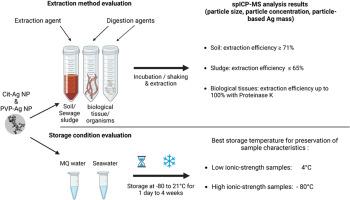Evaluation of extraction and storage conditions for quantification and characterization of silver nanoparticles in complex samples by single particle-ICP-MS
IF 8.1
2区 环境科学与生态学
Q1 ENVIRONMENTAL SCIENCES
引用次数: 0
Abstract
The extraction of nanoparticles (NPs) from complex matrices and subsequent storage can potentially alter the NPs physicochemical properties and hinder cross-study comparisons. Most NPs extraction methods are designed and tested at high NPs concentrations, although (eco)toxicological and regulatory monitoring programs require methods capable of analyzing NPs at environmentally relevant concentrations (lower ppb range). In this study, we investigated how extraction methods affect the characteristics of PVP coated and citrate-stabilized silver NPs (AgNPs) spiked into soil, sewage sludge, and biological samples at environmentally relevant concentrations using Single Particle Inductively Coupled Plasma Mass Spectrometry spICP-MS). Further we investigated the impact of storage temperature (-80 °C – 21 °C) and storage duration (1–28 days) on the particle characteristics such as particle size.
We found that aqueous AgNPs samples with low ionic strength media retained their original characteristics (like particle size, particle concentration and particle-based Ag mass) when preserved at 4 °C for up to 28 days. AgNPs dispersed in high ionic strength media were however better preserved at −80 °C. Among the extraction agents, tetrasodium pyrophosphate was efficient in extracting AgNPs from soil and sewage sludge matrices, while Proteinase K was most suitable for biological samples from organisms (earthworms or fish).
Although our study focused only on AgNPs, it provides crucial information to aid interlaboratory comparisons and data interpretation for (eco)toxicological studies.

评估利用单颗粒-ICP-MS 对复杂样品中的纳米银颗粒进行定量和定性的提取和储存条件。
从复杂基质中提取纳米粒子(NPs)以及随后的储存可能会改变 NPs 的物理化学特性,并妨碍交叉研究比较。大多数 NP 提取方法都是在高浓度纳米粒子的条件下设计和测试的,而(生态)毒理学和监管监测计划需要能够在环境相关浓度(低 ppb 范围)下分析 NPs 的方法。在本研究中,我们使用单颗粒电感耦合等离子体质谱法(Single Particle Inductively Coupled Plasma Mass Spectrometry spICP-MS)研究了萃取方法如何影响在土壤、污水污泥和生物样品中添加环境相关浓度的 PVP 涂层和柠檬酸盐稳定银纳米粒子(AgNPs)的特性。此外,我们还研究了储存温度(-80°C 至 21°C)和储存时间(1-28 天)对粒径等颗粒特性的影响。我们发现,低离子强度介质的 AgNPs 水溶液样品在 4°C 下保存长达 28 天后,仍能保持其原有特性(如粒度、颗粒浓度和基于颗粒的银质量)。然而,分散在高离子强度介质中的 AgNPs 在 -80°C 下保存得更好。在萃取剂中,焦磷酸钠从土壤和污水污泥基质中萃取 AgNPs 的效率更高,而蛋白酶 K 则更适合生物(蚯蚓或鱼)的生物样本。虽然我们的研究只侧重于 AgNPs,但它为实验室间比较和(生态)毒理学研究的数据解释提供了重要信息。
本文章由计算机程序翻译,如有差异,请以英文原文为准。
求助全文
约1分钟内获得全文
求助全文
来源期刊

Chemosphere
环境科学-环境科学
CiteScore
15.80
自引率
8.00%
发文量
4975
审稿时长
3.4 months
期刊介绍:
Chemosphere, being an international multidisciplinary journal, is dedicated to publishing original communications and review articles on chemicals in the environment. The scope covers a wide range of topics, including the identification, quantification, behavior, fate, toxicology, treatment, and remediation of chemicals in the bio-, hydro-, litho-, and atmosphere, ensuring the broad dissemination of research in this field.
 求助内容:
求助内容: 应助结果提醒方式:
应助结果提醒方式:


